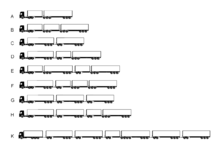B-train

A B-train (in the road transport or trucking industry) consists of two trailers linked together by a fifth wheel, and are up to 26 m (85 ft) long. The fifth wheel coupling is located at the rear of the lead, or first, trailer and is mounted on a "tail" section commonly located immediately above the lead trailer axles.[1] In North America this area of the lead trailer is often referred to as the "bridge". The twin-trailer assembly is hooked up to a tractor unit via the tractor unit's fifth wheel in the customary manner.
An advantage of the B-train configuration is its inherent stability when compared to most other twin trailer combinations, and it is this feature above all else that has ensured its continued development and global acceptance.[2]
Although known as a B-train in many countries, this particular twin trailer combination is also known by the term interlink in Southern Africa and as a B-double in Australia.
B-train trailers are used to transport many types of load and examples include tanks for liquid and dry-bulk, flat-beds and curtain-siders for deck-loads, bulkers for aggregates and wood residuals, refrigerated trailers for chilled and frozen goods, vans for dry goods, logging trailers for forestry work and cattle liners for livestock.
The B-train principle has been exploited to its full potential in Australia, where new configurations such as B triples, double-B doubles and 2AB quads are now seen where permitted. Standard semi-trailers are permitted on almost any road. B-doubles are more heavily regulated, but routes are made available by state governments for almost anywhere that significant road freight movement is required. In South Australia, B-triples up to 35.0 metres (114.8 ft) and two-trailer road trains to 36.5 metres (120 ft) are generally only permitted on specified routes in the north and west of the state, including access to industrial and export areas near Port Adelaide via Port Wakefield Road and Augusta Highway. Larger road trains up to 53.5 metres (176 ft) are only permitted on the Stuart Highway and Olympic Dam Highway in the Far North.[3]

See also
- Road train – longer road-legal vehicle combinations
References
- ↑ "Code of Practice for B-Doubles" (PDF). Government of South Australia, Department for Transport, Energy and Infrastructure. June 2011. p. 3. MR 414 06/11. Retrieved 8 February 2016.
- ↑ Sweatman, P.; Tso, Y. (29 July 1988). "Dynamic stability of B‐doubles". Transportation Planning and Technology. 14 (2): 159–169. doi:10.1080/03081068908717423. Retrieved 8 July 2016.
- ↑ RAVnet (Map). Government of South Australia. Retrieved 21 October 2016.
External links
![]() Media related to B-Trains at Wikimedia Commons
Media related to B-Trains at Wikimedia Commons